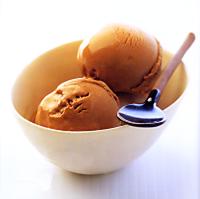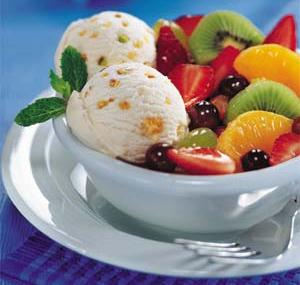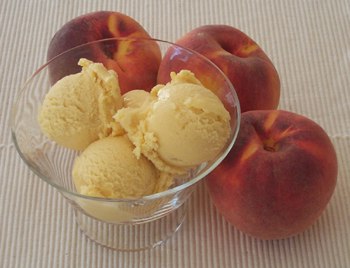Industrial Ice Cream
Ingredients Used in Ice creams
The main constituents of ice cream are fat, milk solids-not-fat (skim-milk
powder), sugar, gelatine (or other suitable stabilizer), egg and
flavouring.
A variety of milk products can be used: cream, whole milk, condensed
milk and instant skim-milk powder. The recipes stated below proved
satisfactory using whipping cream (32-35% fat), table cream (18% fat)
and whole milk. The fat gives the product richness, smoothness and
flavour. Skim-milk powder is used to increase the solids content of
the ice cream and give it more body. It is also an important source
of protein which will improve the ice cream nutritionally. Use good
quality, fresh powder to avoid imparting a stale flavour to the ice
cream.
Liquid coffee whitener (usually purchased frozen) is a cream
substitute in one of the recipes. It will yield a slightly different
flavour which is still very acceptable. The texture of the ice cream
is very creamy. Liquid coffee whitener offers the convenience of
being stored frozen in your freezer and is readily available if a
quick decision is made to make ice cream.
Sugar is a common ingredient to use as a sweetener. It increases the
palatability and improves the body and texture.
The next ingredient, gelatine (or similar substance) assists in
absorbing some of the free water in the ice cream mix and helps
prevent the formation of large crystals in the ice cream.
It also gives substance or a less watery taste when the ice cream is
consumed. The eggs are added to make the fat and water more miscible
and also to improve the whipping ability which gives the ice cream
greater resistance to melting.
Although vanilla is the flavour added to all of the mixes listed
below, you may add flavours to suit you taste.
Preparation of the Ice Cream Mix
The mix (unfrozen ice cream) has to be cooked (pasteurized). For
pasteurizing the mix, it is best to use a double boiler to prevent
scorching.
Place the liquid ingredients (milk, cream or coffee whitener) in the
upper section of the double boiler. Beat in the eggs and the
skim-milk powder. Mix the gelatine with the sugar and add to the
liquid with constant mixing. While stirring, heat to about 70șC.
Place the container in cold water and cool as rapidly as possible to
below 18șC.
Aging the Ice Cream Mix
The ice cream mix is best if it is aged (stored in the refrigerator)
overnight. This improves the whipping qualities of the mix and the body
and texture of the ice cream. If time does not permit overnight aging,
let the mix stand in the refrigerator for at least four hours. After the
aging process is completed, remove the mix from the refrigerator and
stir in the flavouring.
Freezing the Ice Cream Mix
The freezing procedure has a two-fold purpose, the removal of heat from
the mix and the incorporation of air into the mix. Heat is removed by
conduction through the metal to the salt water brine surrounding the
freezing can. This transfer of heat depends upon the temperature of the
brine, the speed of the dasher and how well the dasher scrapes the cold
mix from the surface of the freezer can. The dasher speed and surface
contact are important to achieve complete removal of the frozen ice
cream from the wall of the freezer can. A brine made from 500 grams of
salt and 5 kilograms of crushed ice (one pail full) makes a good
freezing mixture.
Before starting to freeze the ice cream, make sure all parts of the
freezer coming in contact with the ice cream are clean and have been
scalded. Let the can cool before pouring in the mix. Place the empty can
in the freezer bucket and insert the dasher ensuring both the can and
the dasher are centred. Pour the cold, aged mix into the freezer can.
The can should not be filled over two-thirds full to allow sufficient
room for air incorporation.
Plug in the motor or start turning the crank. Immediately begin adding
crushed ice around the can sprinkling it generously with salt. Try to
add the salt and ice in the same one to ten proportion to get the proper
brine temperature. After the bucket is filled with ice to the overflow
hole, pour a little water over the ice to aid in the melting process.
Freeze the mix for 20 to 30 minutes. If the electric motor stalls,
immediately unplug it. Remove the motor or crank and take the dasher out
of the ice cream. The ice cream will be softly frozen. Scrape the ice
cream from the dasher and either scoop into suitable containers or pack
in the freezer can. Immediately place the ice cream in the deep freeze
to harden.
If freezer facilities are not available, the ice cream can be left in
the can, the lid plugged with a cork and placed back into the bucket.
Repack the freezer with more ice and salt, cover with a heavy towel and
set in a cool place to harden until serving time. This will require
further addition of ice and salt depending on the length of time the ice
cream is being held. The yield from the recipes listed below should be
three to four litres.



